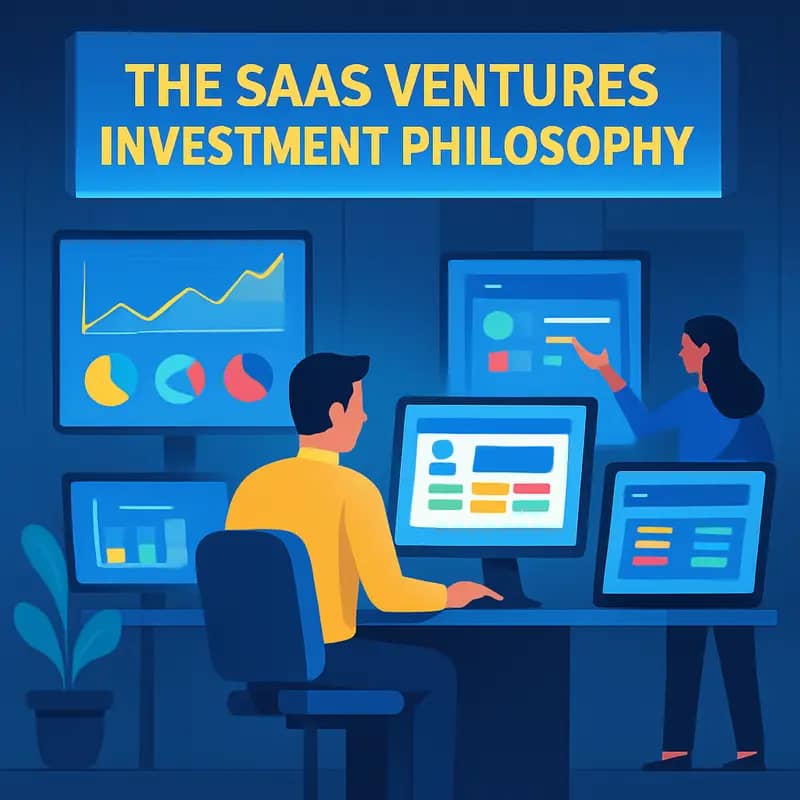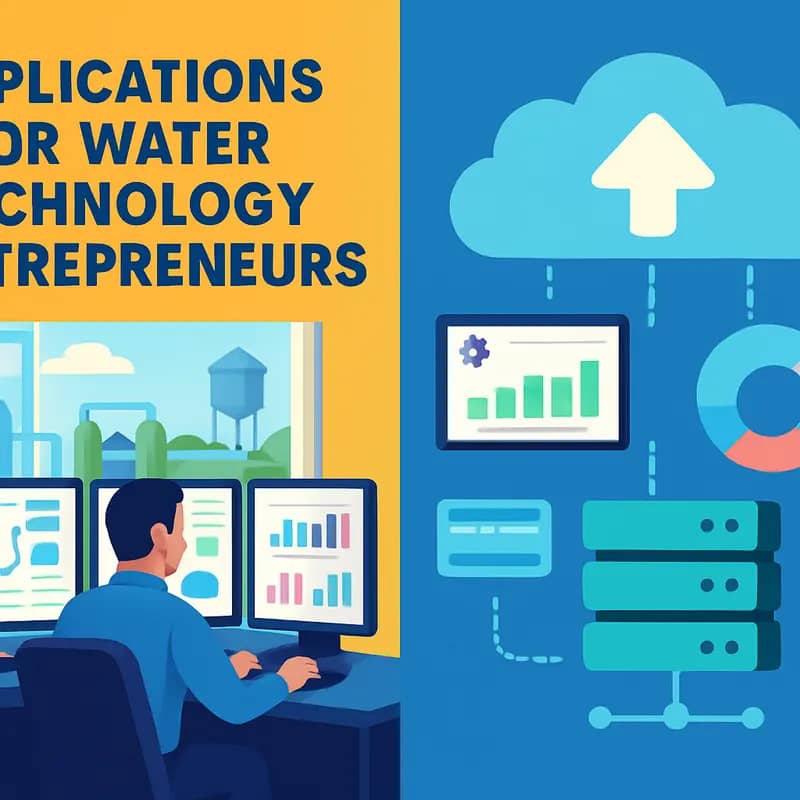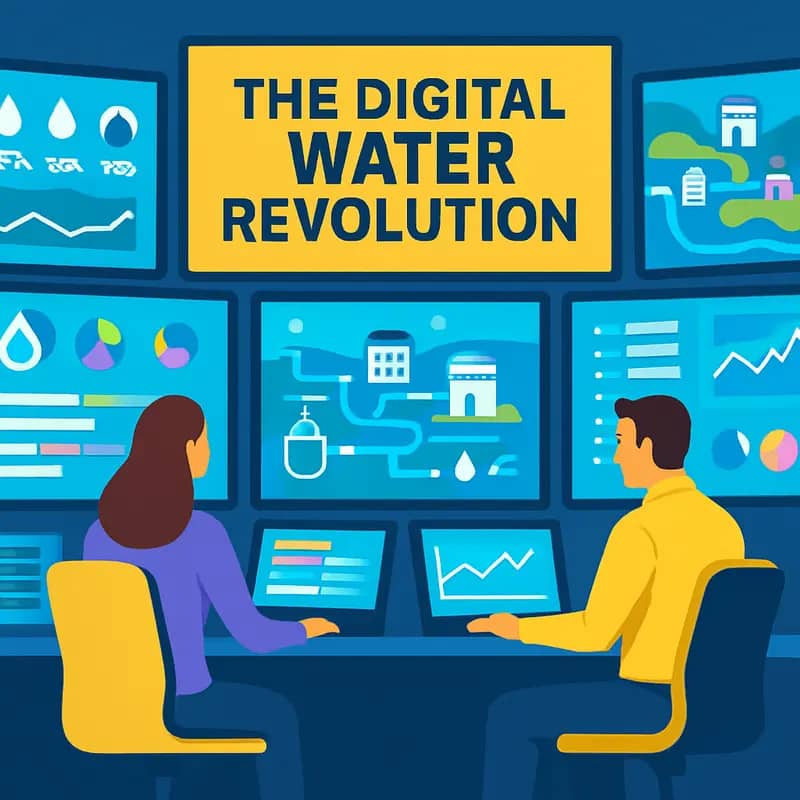In the confluence of enterprise software and water technology lies an intriguing opportunity for both entrepreneurs and investors. SaaS Ventures, headquartered in Bethesda, MD, has carved out a distinctive niche in the B2B software investment landscape. While not explicitly focused on water technologies, their approach to early-stage enterprise software investments offers valuable insights for water entrepreneurs looking to digitize and innovate in their sector. From their co-investment strategy to their geographic focus on emerging tech hubs across the United States, understanding SaaS Ventures’ playbook can help water technology founders better position their solutions for investment consideration.
SaaS Ventures is part of my Ultimate Water Investor Database, check it out!
Investor Name: SaaS Ventures
Investor Type: VC
Latest Fund Size: $ Million
Dry Powder Available: Yes
Typical Ticket Size: $1M – $3M
Investment Themes:
Investment History: $5033333.33 spent over 2 deals
Often Invests Along: Bowery Capital, Spider Capital
Already Invested In: Klir
Leads or Follows: Follow
Board Seat Appetite: Moderate
Key People: Brian Gaister, Collin Gutman, Dan Eidell, Jesse Bloom
The SaaS Ventures Investment Philosophy

SaaS Ventures has carved out a distinctive niche in the venture capital landscape by maintaining an unwavering focus on B2B enterprise software investments. The firm’s investment philosophy centers on identifying early-stage companies that demonstrate strong potential for scalable growth within the enterprise software sector.
At the core of their strategy lies a deep understanding of the B2B software market’s unique dynamics. Unlike consumer-focused startups, enterprise software companies typically follow more predictable growth trajectories, with clearer paths to monetization and longer-term customer relationships. Read more about venture capital dynamics in water tech.
The firm’s investment thesis rests on three fundamental pillars. First, they prioritize solutions that address critical business pain points rather than incremental improvements. This approach ensures their portfolio companies develop products with clear value propositions and strong market demand. Second, they focus on startups with proven product-market fit, even if at a small scale, rather than betting on purely theoretical business models. Third, they value founding teams that combine deep domain expertise with the ability to execute effectively in competitive markets.
What sets SaaS Ventures apart is their geographical strategy. While many VC firms cluster around traditional tech hubs, they actively seek opportunities in emerging tech ecosystems, particularly along the East Coast. This approach allows them to identify promising companies that might be overlooked by Silicon Valley investors while benefiting from typically more favorable valuations.
In evaluating potential investments, the firm employs a rigorous due diligence process that examines not just financial metrics but also technical architecture, market positioning, and customer engagement models. They particularly value companies that demonstrate strong customer retention metrics and efficient capital utilization – hallmarks of sustainable B2B software businesses.
Their portfolio strategy reflects a balanced approach to risk management. While they maintain high standards for investment selection, they recognize that early-stage investing requires patience and strategic support beyond capital injection. This philosophy has led them to develop a hands-on approach to portfolio company development, often taking active roles in helping companies refine their go-to-market strategies and build robust sales processes.
The firm’s investment thesis particularly resonates in sectors where software can drive significant operational efficiencies or enable new business models. This includes areas like enterprise workflow automation, data analytics, and vertical-specific software solutions – segments where the combination of technical innovation and business process improvement can create substantial value.
Co-Investment Strategy and Partnership Dynamics

SaaS Ventures has cultivated a distinctive approach to co-investment that emphasizes collaborative relationships while maintaining strategic autonomy. The firm typically deploys initial investments ranging from $750,000 to $1.5 million, positioning itself as a significant but not dominant player in early-stage funding rounds.
A cornerstone of their co-investment strategy lies in their ability to work harmoniously with both larger venture capital firms and specialized investors. This approach allows them to participate in deals that might otherwise be outside their typical investment range, while also providing portfolio companies with diverse expertise and network access.
Strategic Partnership Selection
The firm demonstrates particular acumen in selecting co-investment partners who complement their core competencies in B2B enterprise software. Rather than competing directly with larger funds, they often serve as the sector expert, bringing deep technical knowledge and operational experience in enterprise software deployment. This positioning has proven especially valuable in deals where water technology intersects with enterprise software solutions.
SaaS Ventures has developed a sophisticated framework for evaluating potential co-investment opportunities, focusing on alignment in investment thesis, time horizons, and exit strategies. Their partnership model typically involves:
- Joint due diligence processes that leverage each partner’s expertise
- Coordinated post-investment support mechanisms
- Clear delineation of responsibilities in portfolio company oversight
- Shared risk assessment and mitigation strategies
Value-Add Dynamics
Beyond capital contribution, SaaS Ventures brings specific value to co-investment scenarios through their deep understanding of enterprise software sales cycles, technical infrastructure requirements, and scaling challenges. This expertise often proves crucial in water technology investments, where enterprise software solutions intersect with traditional infrastructure needs.
Their co-investment approach also incorporates a unique feedback loop system, where insights gained from one partnership inform and enhance future collaboration opportunities. This iterative learning process has helped them refine their partner selection criteria and optimize their value proposition in co-investment scenarios.
Syndicate Leadership
While not always leading investment rounds, SaaS Ventures frequently takes an active role in syndicate formation. They leverage their sector expertise and network to help construct investor groups that provide complementary capabilities and resources. This approach has proven particularly effective in complex deals requiring multiple layers of expertise and capital sources.
Geographic Focus and Market Reach

While many venture capital firms cluster around Silicon Valley, SaaS Ventures has strategically positioned itself to capitalize on emerging technology hubs across the Eastern seaboard and beyond. This geographic focus stems from a deep understanding that innovation isn’t confined to traditional tech centers.
The firm’s East Coast emphasis reflects a calculated approach to identifying undervalued opportunities in regions with strong engineering talent pools and lower operating costs. Key target markets include emerging tech clusters in cities like Baltimore, Philadelphia, and Research Triangle Park, where numerous water technology startups benefit from proximity to major research institutions and industrial centers.
Beyond the East Coast, SaaS Ventures maintains a pragmatic expansion strategy that follows talent and opportunity rather than conventional wisdom. The firm has developed a particularly nuanced understanding of how regional differences impact B2B software adoption, especially in regulated industries like water utilities. This knowledge proves invaluable when evaluating potential investments in water technology solutions that must navigate complex local regulatory frameworks.
The geographic strategy also enables closer relationships with regional co-investors and strategic partners, creating strong local networks that can accelerate portfolio company growth. This approach aligns well with water technology ventures, which often require deep connections to municipal customers and industrial end-users in specific geographic markets.
Notably, the firm’s investment thesis recognizes that water technology solutions often need to be validated in specific regional contexts before scaling nationally. This understanding has led to a hub-and-spoke model where portfolio companies can establish strong regional footholds before expanding into adjacent markets.
The firm’s geographic reach extends into secondary and tertiary markets often overlooked by coastal VCs, creating opportunities to identify and nurture promising water technology innovations addressing specific regional challenges. This approach has proven particularly effective in identifying B2B SaaS solutions that solve water management challenges unique to different geographic regions.
In keeping with their strategic vision, SaaS Ventures leverages regional expertise to help portfolio companies navigate local market dynamics while building scalable solutions with national potential. This geographic focus has become increasingly relevant as water technology adoption patterns show significant regional variation, influenced by local water stress levels, regulatory requirements, and infrastructure needs.
Learn more about navigating venture capital in the water sector.
Implications for Water Technology Entrepreneurs

Water technology entrepreneurs seeking investment from SaaS Ventures must understand how to position their solutions within the firm’s B2B enterprise software focus. This requires a fundamental shift in how water tech startups approach their business models and go-to-market strategies.
Successful alignment starts with reimagining water technology solutions through a software-first lens. Rather than leading with hardware capabilities, entrepreneurs should emphasize the data, analytics, and workflow automation aspects of their offerings. This could mean highlighting how sensor networks generate actionable insights, how machine learning optimizes treatment processes, or how cloud platforms enable predictive maintenance.
The recurring revenue model is crucial for catching SaaS Ventures’ attention. Water tech startups traditionally relied on equipment sales and project-based income. However, transitioning to subscription-based services – whether through monitoring-as-a-service, predictive analytics, or performance optimization platforms – creates the predictable cash flows venture investors seek.
Scale and market size matter significantly to SaaS Ventures’ investment thesis. While many water tech companies focus on solving specific technical challenges, successful funding requires demonstrating how solutions can rapidly expand across multiple customer segments and geographies. Entrepreneurs should articulate clear paths to reaching enterprise customers beyond initial municipal or industrial pilots.
Water technology startups must also demonstrate strong unit economics and capital efficiency. Unlike hardware-centric business models with high upfront costs, software-driven approaches should show improving margins as they scale. This aligns with SaaS Ventures’ expectations for capital-efficient growth.
The implications extend beyond individual companies to the broader water technology ecosystem. As more startups successfully integrate software-centric models, we’ll likely see increased venture capital flowing into the sector. This could accelerate innovation and adoption of digital water solutions across utilities and industry.
Knowledge of SaaS Ventures’ investment criteria provides a valuable template for water entrepreneurs seeking venture funding. By building software-driven business models with recurring revenue, clear paths to scale, and capital-efficient growth, startups can position themselves for successful fundraising while driving digital transformation in the water sector.
As explored in how one startup succeeded with software-first water solutions, companies that effectively combine domain expertise with SaaS business models are proving particularly attractive to investors like SaaS Ventures. This hybrid approach may become the dominant model for water technology innovation and investment in the years ahead.
The Digital Water Revolution

Water infrastructure is undergoing a fundamental transformation as cloud computing and software solutions reshape how utilities monitor, maintain, and optimize their systems. This digital revolution represents a pivotal shift from reactive to proactive water management, enabling unprecedented visibility and control over water networks.
Advanced sensors and IoT devices now form intricate digital nervous systems throughout water infrastructure, continuously collecting data on flow rates, pressure, water quality, and equipment performance. This real-time monitoring capability allows utilities to detect and address issues before they escalate into service disruptions or compliance violations.
The true power of this digital transformation lies in how cloud platforms aggregate and analyze the massive volumes of sensor data. Machine learning algorithms can now predict maintenance needs, optimize treatment processes, and even forecast demand patterns with remarkable accuracy. For example, smart metering systems have helped utilities reduce non-revenue water losses by up to 30% by swiftly identifying leaks and unusual consumption patterns.
In wastewater operations, digital solutions are revolutionizing treatment plant efficiency. Smart process control systems automatically adjust chemical dosing and aeration based on incoming load characteristics, reducing energy consumption while maintaining treatment quality. Remote monitoring capabilities enable operators to manage multiple facilities from central control rooms, improving staff efficiency and safety.
Perhaps most significantly, digital transformation is enabling entirely new business models in the water sector. The emergence of Water-as-a-Service offerings allows industrial customers to outsource their water management entirely, with service providers using digital platforms to deliver guaranteed water quality and quantity while optimizing resource use.
The market opportunity is substantial – experts project the smart water management sector to exceed $50 billion by 2028. However, this growth depends on overcoming key challenges around cybersecurity, data standardization, and workforce digital literacy. Successful implementations require careful attention to change management and stakeholder engagement.
Utilities embracing digital transformation are seeing dramatic improvements in operational efficiency, customer service, and environmental performance. As climate change and aging infrastructure create mounting pressure on water systems, these smart, connected solutions will become increasingly critical for ensuring sustainable water management.
The transformation extends beyond individual facilities to enable integrated watershed management through digital twins and predictive modeling. These tools help utilities and municipalities better understand system interactions and make more informed planning decisions about infrastructure investments.
Market Dynamics and Investment Landscape

The water technology SaaS sector stands at an inflection point, with venture capital flowing into innovative solutions that address critical infrastructure needs. Investment data reveals a compelling growth trajectory, with water tech funding rounds reaching $2.1 billion in 2023 – a 40% increase from the previous year.
Institutional investors increasingly recognize the sector’s defensive characteristics and growth potential. Water tech SaaS companies demonstrate strong recurring revenue models, with typical gross margins exceeding 70%. The market’s expansion stems from mounting pressures on water infrastructure, regulatory compliance requirements, and sustainability mandates.
A notable shift is occurring in investment patterns, moving from hardware-centric solutions toward integrated software platforms that optimize existing infrastructure. Asset management, predictive maintenance, and real-time monitoring solutions attract particular interest. Early-stage deals in these categories averaged $5-15 million in 2023, while growth-stage rounds regularly exceeded $30 million.
Two key trends are reshaping the investment landscape. First, utilities’ growing comfort with cloud-based solutions has accelerated SaaS adoption rates. Second, the convergence of water management with broader ESG initiatives has attracted impact-focused capital. As noted in the unpopular yet true analysis of water venture capital, successful investments require deep sector expertise and patient capital deployment.
Emerging opportunities center on three key areas: AI-powered analytics for infrastructure optimization, regulatory compliance automation, and digital twins for scenario planning. These segments show compound annual growth rates of 25-35%, driven by aging infrastructure replacement cycles and stricter environmental standards.
Despite positive momentum, challenges remain. The sector’s fragmented nature and long sales cycles require investors to maintain extended holding periods. Successful ventures typically demonstrate strong partnerships with established industry players and clear paths to scale across multiple utility systems.
The competitive landscape continues to evolve as strategic acquirers become more active. Traditional water industry players increasingly view SaaS acquisitions as critical to their digital transformation strategies, providing attractive exit opportunities for well-positioned startups. This dynamic creates favorable conditions for early-stage investors with sector expertise and the ability to accelerate commercial adoption.
Building a Sustainable Water Tech Startup

Building a sustainable water technology startup requires careful navigation of unique industry dynamics and regulatory requirements. Success hinges on understanding both technical and business fundamentals while maintaining focus on long-term environmental impact.
Regulatory compliance forms the foundation of any water tech venture. Entrepreneurs must become intimately familiar with the Clean Water Act, Safe Drinking Water Act, and state-specific regulations that govern water quality standards and treatment processes. Early engagement with regulatory bodies helps avoid costly pivots later.
When developing go-to-market strategies, water tech startups should consider the industry’s inherently conservative nature. Water utilities and industrial customers prioritize reliability and proven solutions over cutting-edge innovation. This necessitates extensive pilot testing and validation before wide-scale adoption. Learn more about piloting strategies.
Scaling presents unique challenges in the water sector. Unlike typical SaaS businesses, water tech often requires significant capital expenditure for hardware and infrastructure. Finding the right balance between software and hardware components is crucial. Successful startups typically start with a focused solution for a specific use case or customer segment before expanding.
Data management and security deserve special attention. Water utilities handle sensitive infrastructure information, making cybersecurity non-negotiable. Startups must implement robust data protection measures while ensuring their solutions integrate seamlessly with existing operational technology systems.
Pricing models require careful consideration. Traditional software subscription models may need adaptation for the water sector’s lengthy procurement cycles and budget constraints. Consider performance-based pricing tied to measurable outcomes like water savings or treatment efficiency.
Partnerships play a vital role in growth. Established equipment manufacturers, engineering firms, and system integrators can provide valuable distribution channels and credibility. However, partnership agreements must protect intellectual property while ensuring fair value distribution.
Funding strategies should align with the sector’s extended commercialization timelines. While venture capital can accelerate growth, entrepreneurs should also explore alternative funding sources like government grants, corporate partnerships, and impact investors focused on water sustainability.
Most importantly, successful water tech startups maintain unwavering focus on delivering measurable environmental and economic benefits. This dual bottom line approach – combining profitable operations with positive environmental impact – creates resilient businesses capable of attracting both customers and investors.
Impact Metrics and Success Stories

The quantifiable impact of water technology SaaS ventures extends far beyond traditional business metrics, delivering both environmental and economic returns that demonstrate the sector’s transformative potential. Recent success stories highlight how data-driven solutions are revolutionizing water management across industries.
A standout achievement comes from smart metering and analytics implementations across municipal water systems. Advanced leak detection algorithms paired with real-time monitoring have helped utilities reduce non-revenue water losses by up to 40% while cutting associated energy usage by 25%. The environmental impact translates to billions of gallons of water saved annually.
In the industrial sector, AI-powered process optimization tools have enabled manufacturing facilities to decrease their water consumption by 30-35% on average. The most successful implementations combine continuous monitoring with predictive maintenance, achieving ROI periods of 12-18 months through reduced operational costs and compliance violations.
The agricultural vertical presents particularly compelling metrics. Smart irrigation systems leveraging soil moisture sensors and weather data have demonstrated water savings of 40-50% compared to traditional methods. When scaled across large operations, these solutions generate six-figure annual cost reductions while preserving groundwater resources.
Perhaps most encouraging are the accessibility gains enabled by SaaS models. Cloud-based platforms have lowered barriers to adoption, allowing smaller utilities and agricultural operations to access enterprise-grade capabilities through subscription pricing. This democratization of water tech has expanded the solutions’ impact to previously underserved markets.
Beyond direct resource conservation, these platforms generate valuable data insights that drive continuous improvement. Machine learning models trained on operational data help identify optimization opportunities, while benchmarking capabilities enable the sharing of best practices across user networks. The network effects compound the environmental benefits over time.
The financial metrics reinforce the business case. Early adopters report operational cost reductions of 20-30% on average, with some achieving payback periods as short as 6-8 months. More importantly, the recurring revenue model has proven resilient, with typical customer retention rates above 95% annually.
Looking ahead, the integration of additional data streams and advancement of predictive capabilities promises even greater impact. The convergence of IoT sensors, edge computing, and artificial intelligence is enabling a new generation of solutions that could help close the global water infrastructure gap while delivering attractive returns for investors.
Final words
While SaaS Ventures may not explicitly target water technology investments, their approach to B2B enterprise software funding offers valuable lessons for water entrepreneurs. Their emphasis on co-investment, focus on early-stage companies, and strategic geographic targeting demonstrates a thoughtful approach to building sustainable software businesses. For water technology entrepreneurs, the key takeaway is the importance of positioning their solutions not just as water innovations, but as scalable enterprise software platforms that can attract diverse investor interest. The intersection of water technology and SaaS presents unique opportunities for those who can effectively bridge these worlds. Success lies in developing solutions that not only address critical water challenges but also demonstrate the scalability, recurring revenue potential, and enterprise-grade capabilities that firms like SaaS Ventures seek in their portfolio companies. As the water sector continues its digital transformation, understanding and aligning with such investment perspectives becomes increasingly crucial for securing the capital needed to drive innovation forward.
Wanna explore the Full List of Water Investors that cut at least two checks over the past decade? Check it out and bookmark it, I update it regularly!
Learn more: https://dww.show/the-ultimate-water-investor-database/
About us
Through my “(don’t) Waste Water” platform, I offer unique and insightful coverage of the water industry that combines technical expertise with engaging storytelling. If you haven’t yet, it might be time for you to subscribe to the podcast, the youtube channel and/or the newsletter!
